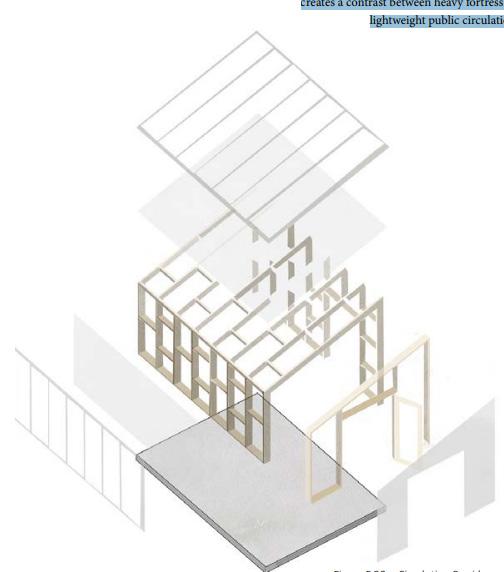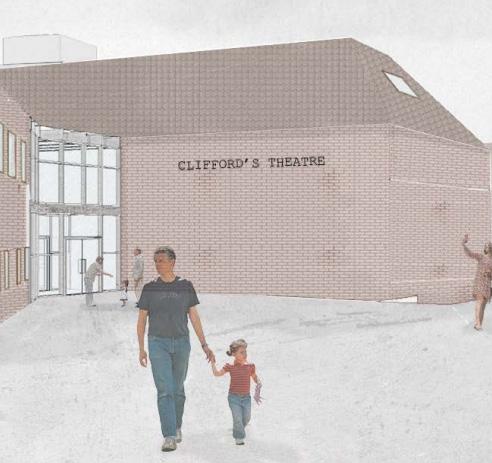
THE ESCAPE
/PROJECT SUMMARY
/PLANS, SECTIONS, VISUALISATIONS
/CONSTRUCTION & SUSTAINABILITY
CLIFFORD'S THEATRE

/PROJECT SUMMARY
/ PLANS, SECTIONS, VISUALISATIONS
/ CONSTRUCTION & SUSTAINABILITY





/PROJECT SUMMARY
/PLANS, SECTIONS, VISUALISATIONS
/CONSTRUCTION & SUSTAINABILITY

/PROJECT SUMMARY
/ PLANS, SECTIONS, VISUALISATIONS
/ CONSTRUCTION & SUSTAINABILITY



Community-led therapeutic space for users struggling with depression and identity crisis
Location: Fountainbridge Area, Harrison Park, Edinburgh along the Union Canale (site coordinates: 55.932897, -3.226410).
Project date: 2023
Description: The project is called THE ESCAPE: Space of Healing. By the author’s idea, it is a collaboration between the local government and an independent mental health care provider (similar to the Priory organisation) that will also become an owner-occupant since their office, management, and staff will be housed in the complex.

Objectives: Given the rise in suicide, depression, and anxiety rates in Edinburgh’s population , the project seeks to use design and accommodated activities to help improve mental health and well-being on both a societal and individual level. The goal of THE ESCAPE is not only to impact the well-being of an individual struggling with depression, identity crisis, and anxiety but also to create a space where inclusive, aware communities could be built, therefore, it aims to enlighten the public in the field of psychology and mental healthcare through the lectures and presentations held on THE ESCAPE building complex premises.
To achieve the project goals through architectural design, a newbuilt complex consists of three main blocks and can be classified as a mixed land use building complex as it includes a residential building, an institutional building, and an assembly building.


When the project brief was drawn up, it was decided to design three separate buildings for various activities in order to provide maximum comfort for both staff and users :
In the brief client outline several key aspects, which should be prioritised in the project: build local communities, address mental health, well-being, tranquility, and privacy of the users through design, provide employment possibility in the area, and develop an environmentally sustainable design
Each building is strategically positioned on the site and has its unique characteristics in terms of material choice, lighting, and shape in order to meet the client’s requirements for the architectural concept, which is that the building complex should perform as a healing mindful walk for its users, creating a balance between a sense of privacy and community

13, 15, 16, 18, 19, 21, 22, 24, 26, 27 - Individual rooms (mezzanine)
14, 17, 20, 23, 25 - Rooms for two people (mezzanine)


1 - Lobby
2 - Reception
3 - Exhibition space
4 - Changing room
5 - Pottery workshop
6 - Storage room
7 - Arts workshop
8 - Lecture theatre
9 - WC
10 - Cafeteria
11 - Kitchen
12 - Staff changing room
Figure 1.5 - Activity Building First Floor Plan (1:100)


 Figure 1.7 - Activity Building Long Section (1:100)
Figure 1.7 - Accommodation Building Cross Section (1:100)
Figure 1.7 - Activity Building Long Section (1:100)
Figure 1.7 - Accommodation Building Cross Section (1:100)
 Figure 1.7 - Activity Building North Elevation (1:100)
Figure 1.7 - Activity Building North Elevation (1:100)
The diagram represents how the main building elements are layered. In-situ reinforced concrete core performs as load-bearing structure. The structure is insulated and clad with prefabricated timber panels as well as finished with prefabricated, curved timber frames wrapped in glazing.


Recycled concrete According to circular economy principles it is responsible to reuse products and materials rather than extracting new resources, therefore, the constructional core will be made out of recycled concrete aggregate, which is produced out of crushed demolition waste.
In order to reduce transportation distance and embodied energy, the recycled concrete aggregate will be sourced from local demolition sites.
Layer 2 - in-situ concrete
Layer 3 - Insulation
Layer 4 - Prefabricated timber panels
Layer 1 - Reinforeced
Figure 1.8 - Construction diagramThe building has a continuous insulation, continuous vapor control barrier, sufficient waterproofing and water drainage system. The roof is slightly curved, therefore, the water easily gets to the water drain.



Key sustainability goals of the project are: use of prefabricated panels and frames to reduce construction waste, maximisation of natural lighting in workshops, lecture theatres and library by means building orientation and opening placement, maximisation of natural ventilation, use of recycled concrete, incorporation of south facing solar panels and provision of a durable construction
 Figure 1.11- Activity Building South Elevation
Figure 1.11- Activity Building South Elevation
Space to explore movement, performance and local history
Location: Cliffords Fort Moat, North Shields, NE30 1JE
Project date: 2022
Description: Clifford’s Theatre is called after the main jewel of Fish QuayClifford’s Fort, which also became one of the inspirations for design concept. The building is fully community led and houses three main activities: teaching dance, performing dance and presenting local history. Main goals of the project are to build communities, embrace history and particularities of the site, provide durable construction flexible in use, attractive tourists and help development of local economy.

Sustainability & Biodiversity Objectives: In order to increase sustainability bricks used in cladding will be collected from the adjacent construction sites and reclaimed. Existing brick walls on the western and northern sides of the site will be dismantled, reclaimed and also used as a cladding. For the glazed curtain wall construction will be used recycled steel. Strategic placement of window and skylights aims to maximise natural lighting and ventilation in order to reduce energy use.
The project aims to encourage local wildlife, therefore green areas around the site will be treated as petite biodiversity gardens.






 Figure 2.6 - Clifford’s Theatre Reception & Exhibition area
Figure 2.6 - Clifford’s Theatre Reception & Exhibition area
Space of community and sense of true home
Location: Shieldfield, Newcastle upon Tyne NE2 1UY
Project date: 2021
Description: The design might be characterized as a five-story structure featuring a single-story void that forms a communal outdoor area on the southern side. The building’s layout is such that most of the shared spaces are situated on the ground floor. The northern section of the building is allocated for office spaces available for rent, aiming to encourage local business growth. Meanwhile, the first through fourth floors house apartments, with each floor accommodating 6 flats.

The project puts the emphasis on three primary concepts that served as the core inspiration for the design. Following this, I will delve into these ideas with greater elaboration: adaptability of space, seamless mobility and inclusivity for individuals with disabilities, balancing involvement and personal space
By saying «space flexibility» I mean its adaptability depending on users needs. Reading the sources such as Radical Housing, I understood that the spaces of multigenerational housing should be customisable «perform» successfully.








 Figure 3.7 - 4th Floor
Figure 3.7 - 4th Floor
As I already mentioned, requirements and understanding of comfort for each users group is different, thus I would like to give them an opportunity to personalise, change and customise their own space.
The design is also driven by the idea to make space for disabled people, where they would feel comfortable and less limited in terms of movement. I have don a little study of «designing space for disabled people». So ho it affected the The building has wider door openings and corridors, more «opened spaces»,
the area allottedfor bathrooms and an elevator is calculated to enable the movement of wheelchair.( Such decisions also provide comfortable movementfoe people with strollers). Designing the building, I wanted to provide privacy as well as engagement for my users. I was thinking about privacy on different scales: privacy and engagement in the whole building; privacy and engagement in a flat.
 Figure 3.8 - Multi-Generational House South Facade
Figure 3.8 - Multi-Generational House South Facade
Community-led therapeutic space for users struggling with depression and identity crisis
Location: Cullercoats Harbour, Cullercoats
Project date: 2020
The Kayaking Activity Centre serves as a haven for individuals seeking to explore and engage in the exhilarating sport of kayaking against the backdrop of the scenic Cullercoats Harbour. The architectural blueprint not only facilitates the acquisition and refinement of kayaking skills, but also offers the unique provision of accommodation for short stays. This innovative design concept encourages participants not only to immerse themselves in learning and honing their kayaking techniques but also to forge connections with like-minded enthusiasts. Beyond a mere activity hub, the centre transforms into a platform for cultivating communities united by a shared passion for kayaking. By combining instruction, practice, and a temporary dwelling, this project creates an environment that fosters skill development, leisure, and the nurturing of meaningful relationships within the context of this thrilling water sport.



The architectural concept can be characterized as a multi-tiered structure, with a captivating element being the staircase-like apex of the building’s active zone. This unique feature guides individuals from an exposed observation deck down to the shoreline.

The activity center exhibits an atypical shape, mirroring the contours of the preexisting landscape at Cullercoats with seamless integration.
With a focus on user well-being, the design features comfortable bedrooms for privacy from the busy beach, coupled with panoramic activity views. Furthermore, it addresses health concerns through a dedicated first aid room and a watchtower staffed by two members for supervision and safety.


 Figure 1.5 - Activity Building First Level Plan (1:100)
Figure 1.5 - Activity Building First Level Plan (1:100)